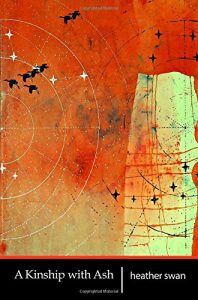Heather Swan: Review by Claire Keyes

Heather Swan: A Kinship with Ash (Terrapin Books)
A Kinship with Ash engages readers with intimate and personal themes that evolve into substantive, environmental issues. Each of the five sections of Heather Swan’s book contains a poem, sometimes two, entitled “Pesticide” followed by the name of a particular brand. The titles evoke cherished concepts and archetypes: Liberty, Calypso, Victor, Luna, Serenade, Vespers . . actual names of products and, of course, maliciously misleading. It may be difficult to imagine a poet opting for pesticides as a topic, but Swan’s approach endows the issue with a compelling intimacy. The first of these poems, subtitled “Liberty,” is dedicated to Deb who appears to be a childhood friend of the speaker who recalls
how we ran through fields
of Queen Anne’s lace, shirtless, our sex
still knotted like tiny fists in our chests,
jeans rolled up to the knees?
. . .
And the clouds of Yellow Sulfur wings
rising around us on days after rain
when they gathered on the drying puddles
in the roads? (p.7)
Childish, innocent they took the natural world for granted: it would always be there. “Before we learned,” the poem ends, about “the real poisons lurking all around us. / Before I started having nightmares, / and you started carrying guns.” (p.7) For the speaker, the sense of change in the natural world inspires dread and fear. Swan’s readers can’t escape similar premonitions. All we have to do is look around or follow weather reports: temperatures over 100 in Portland, Oregon?
Raging forest fires?
But do we look around us? This is where the poet, skilled at looking closely and recording what’s there, can jostle us into awareness. For example, “Pesticides V: Vespers” can be seen as a master class in writing an eco-poem. “Vespers,” the name of a pesticide, also denotes a service of evening prayer. Fittingly, the poem opens with: “by the lakes’ edge at dusk,” locating the reader within the appropriate time, but not in church. We get details of the scene with “a raft of lavender ice,” “seagulls,” and “Redwing blackbirds.” So far, so good: a bucolic nature scene with a note of something awry: those seagulls “reel and vie / for what is vanishing/ months too soon.” And what can that be? The lake ice “is being consumed by / the warming blue.” The reader picks up signals of global warming. It’s not all bucolic. At the center of the poem, the speaker notes the sound of a “train whistle [that] spools / through town—the boxcars / heaped with coal.” Her attention returns to the lake where she notices “scullers thrusting / to the shouts of the coxswain.” Activity, energy and then to close the poem:
on a mat of branches
and sand, quiet as monastics
in a chapel, two cranes
stand perfectly still. (p.74)
These last lines manage to combine the image from nature with a religious reference that brings us back to the spiritual meaning of vespers. Heather Swan (great name for a poet) reminds us of the causes of climate change (those “boxcars heaped with coal”) and the delicate balance needed right now so those cranes can survive, so that natural environments might stay natural and not a cesspool of human transgression.
The concluding poem in this collection, “After,” provides an apocalyptic scene, as if the poet imagines a world devastated by the very pesticides she has highlighted in her text. She tells her reader what to do: “there among the silences / find the ghost tree.” While there is such a thing as a ghost tree or “handkerchief tree,” Swan focuses on its “split black branches.” Why black? Perhaps a forest fire out of control. In such a tree, “the birds can find no purchase,” no promising place to land or perch looking for insects (no insects). Once this tree has been located, Swan directs her reader to:
Scavenge the esker,
make a circle of stones,
Kneel down wreathed in
feather and bracken.
Prepare to knit yourself
back into the world. (p.75)
This ending calls up Swan’s central metaphor: from ashes to ashes, but it’s not morbid. It’s haunting. The poem leads the reader, imaginatively, into a reverential act—making that circle, adorning one’s self in appropriate, natural gear, kneeling. The imagery in these lines evokes the ancient trope of Gaia, the Earth Mother Goddess. A Kinship with Ash moves us further into the natural world: the rivers, the forests, all that we deem “nature.” We may have lost the sense that our species—like all other species—has emerged from this planet we call Earth. Failing to regard and respect this essential connection, we have lost respect for the roots that nourish us. Heather Swan’s poems guide us towards a healthier connection.
Claire Keyes is the author of two collections of poetry: The Question of Rapture (Mayapple Press) and What Diamonds Can Do (WordTech). Winner of the Beullah Rose Poetry Prize from Smartish Pace, she is a recipient of a grant in poetry from the Massachusetts Cultural Council and a fellowship from the Wurlitzer Foundation. She is Professor Emerita at Salem State University and her poems have been published recently in Mom Egg Review, Turtle Island, One Art, and Persimmon Tree.